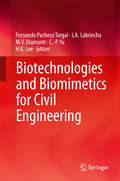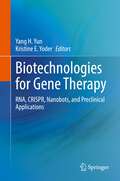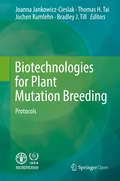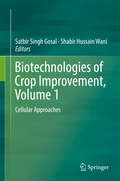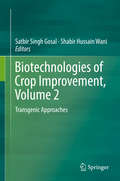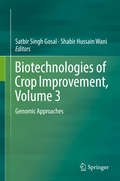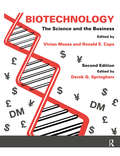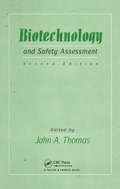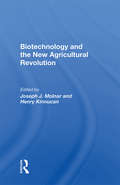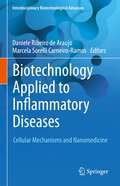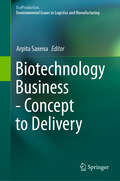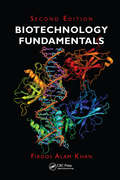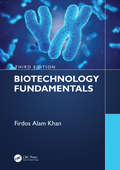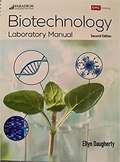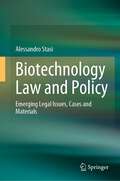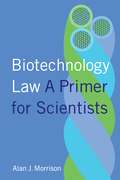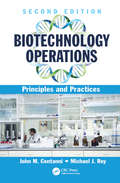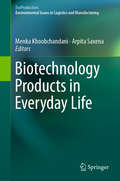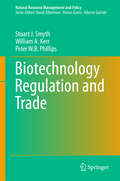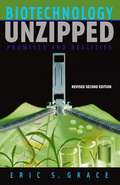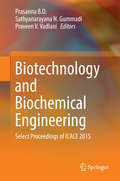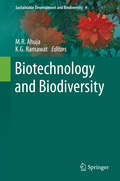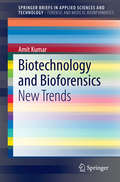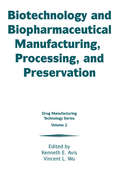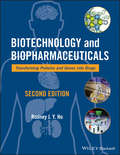- Table View
- List View
Biotechnologies and Biomimetics for Civil Engineering
by Fernando Pacheco Torgal J. A. Labrincha M. V. Diamanti C. P. Yu H. K. LeePutting forward an innovative approach to solving current technological problems faced by human society, this book encompasses a holistic way of perceiving the potential of natural systems. Nature has developed several materials and processes which both maintain an optimal performance and are also totally biodegradable, properties which can be used in civil engineering. Delivering the latest research findings to building industry professionals and other practitioners, as well as containing information useful to the public, 'Biotechnologies and Biomimetics for Civil Engineering' serves as an important tool to tackle the challenges of a more sustainable construction industry and the future of buildings.
Biotechnologies for Gene Therapy: RNA, CRISPR, Nanobots, and Preclinical Applications
by Yang H. Yun Kristine E. YoderThe purpose of this book is to highlight some of latest developments and applications of CRISPR, RNA, and DNA to treat diseases ranging from cancers to cardiovascular and degenerative disorders. It also features innovations of the delivery methods for nucleic acids ranging from nanodevices made from DNA and pseudo amino acids to viral vectors. This is an ideal book for academics, clinicians, and students interested in gene therapy.
Biotechnologies for Plant Mutation Breeding: Protocols
by Joanna Jankowicz-Cieslak Bradley J. Till Jochen Kumlehn Thomas H. TaiThis book is open access under a CC BY-NC 2. 5 license. This book offers 19 detailed protocols on the use of induced mutations in crop breeding and functional genomics studies, which cover topics including chemical and physical mutagenesis, phenotypic screening methods, traditional TILLING and TILLING by sequencing, doubled haploidy, targeted genome editing, and low-cost methods for the molecular characterization of mutant plants that are suitable for laboratories in developing countries. The collection of protocols equips users with the techniques they need in order to start a program on mutation breeding or functional genomics using both forward and reverse-genetic approaches. Methods are provided for seed and vegetatively propagated crops (e. g. banana, barley, cassava, jatropha, rice) and can be adapted for use in other species.
Biotechnologies of Crop Improvement, Volume 1: Cellular Approaches
by Shabir Hussain Wani Satbir Singh GosalDuring the past 15 years, cellular and molecular approaches have emerged as valuable adjuncts to supplement and complement conventional breeding methods for a wide variety of crop plants. Biotechnology increasingly plays a role in the creation, conservation, characterization and utilization of genetic variability for germplasm enhancement. For instance, anther/microspore culture, somaclonal variation, embryo culture and somatic hybridization are being exploited for obtaining incremental improvement in the existing cultivars. In addition, genes that confer insect- and disease-resistance, abiotic stress tolerance, herbicide tolerance and quality traits have been isolated and re-introduced into otherwise sensitive or susceptible species by a variety of transgenic techniques. Together these transformative methodologies grant access to a greater repertoire of genetic diversity as the gene(s) may come from viruses, bacteria, fungi, insects, animals, human beings, unrelated plants or even be artificially derived. Remarkable achievements have been made in the production, characterization, field evaluation and commercialization of transgenic crop varieties worldwide. Likewise, significant advances have been made towards increasing crop yields, improving nutritional quality, enabling crops to be raised under adverse conditions and developing resistance to pests and diseases for sustaining global food and nutritional security. The overarching purpose of this 3-volume work is to summarize the history of crop improvement from a technological perspective but to do so with a forward outlook on further advancement and adaptability to a changing world. Our carefully chosen “case studies of important plant crops” intend to serve a diverse spectrum of audience looking for the right tools to tackle complicated local and global issues.
Biotechnologies of Crop Improvement, Volume 2: Transgenic Approaches
by Shabir Hussain Wani Satbir Singh GosalDuring the past 15 years, cellular and molecular approaches have emerged as valuable adjuncts to supplement and complement conventional breeding methods for a wide variety of crop plants. Biotechnology increasingly plays a role in the creation, conservation, characterization and utilization of genetic variability for germplasm enhancement. For instance, anther/microspore culture, somaclonal variation, embryo culture and somatic hybridization are being exploited for obtaining incremental improvement in the existing cultivars. In addition, genes that confer insect- and disease-resistance, abiotic stress tolerance, herbicide tolerance and quality traits have been isolated and re-introduced into otherwise sensitive or susceptible species by a variety of transgenic techniques. Together these transformative methodologies grant access to a greater repertoire of genetic diversity as the gene(s) may come from viruses, bacteria, fungi, insects, animals, human beings, unrelated plants or even be artificially derived. Remarkable achievements have been made in the production, characterization, field evaluation and commercialization of transgenic crop varieties worldwide. Likewise, significant advances have been made towards increasing crop yields, improving nutritional quality, enabling crops to be raised under adverse conditions and developing resistance to pests and diseases for sustaining global food and nutritional security. The overarching purpose of this 3-volume work is to summarize the history of crop improvement from a technological perspective but to do so with a forward outlook on further advancement and adaptability to a changing world. Our carefully chosen “case studies of important plant crops” intend to serve a diverse spectrum of audience looking for the right tools to tackle complicated local and global issues.
Biotechnologies of Crop Improvement, Volume 3: Genomic Approaches
by Shabir Hussain Wani Satbir Singh GosalDuring the past 15 years, cellular and molecular approaches have emerged as valuable adjuncts to supplement and complement conventional breeding methods for a wide variety of crop plants. Biotechnology increasingly plays a role in the creation, conservation, characterization and utilization of genetic variability for germplasm enhancement. For instance, anther/microspore culture, somaclonal variation, embryo culture and somatic hybridization are being exploited for obtaining incremental improvement in the existing cultivars. In addition, genes that confer insect- and disease-resistance, abiotic stress tolerance, herbicide tolerance and quality traits have been isolated and re-introduced into otherwise sensitive or susceptible species by a variety of transgenic techniques. Together these transformative methodologies grant access to a greater repertoire of genetic diversity as the gene(s) may come from viruses, bacteria, fungi, insects, animals, human beings, unrelated plants or even be artificially derived. Remarkable achievements have been made in the production, characterization, field evaluation and commercialization of transgenic crop varieties worldwide. Likewise, significant advances have been made towards increasing crop yields, improving nutritional quality, enabling crops to be raised under adverse conditions and developing resistance to pests and diseases for sustaining global food and nutritional security. The overarching purpose of this 3-volume work is to summarize the history of crop improvement from a technological perspective but to do so with a forward outlook on further advancement and adaptability to a changing world. Our carefully chosen “case studies of important plant crops” intend to serve a diverse spectrum of audience looking for the right tools to tackle complicated local and global issues.
Biotechnology - The Science and the Business
by Vivian Moses Ronald E. Cape Derek G. SpringhamBiotechnology has not stood still since 1991 when the first edition of Biotechnology - The Science and the Business was published. It was the first book to treat the science and business of technology as an integrated subject and was well received by both students and business professionals. All chapters in this second edition have been updated and revised and some new chapters have been introduced, including one on the use of molecular genetic techniques in forensic science. Experts in the field discuss a range of biotechnologies, including pesticides, the flavor and fragrance industry, oil production, fermentation and protein engineering. On the business side, subjects include managing, financing, and regulation of biotechnology. Some knowledge of the science behind the technologies is assumed, as well as a layperson's view of buying and selling. As with the first edition, it is expected that this book will be of interest to biotechnology undergraduates, postgraduates and those working in the industry, along with students of business, economics, intellectual property law and communications.
Biotechnology And Safety Assessment
by J. A. ThomasThis updated text explains how advances in mammalian and plant genetics contribute to better therapeutics agents and more wholesome foods. It addresses such topics as new pharmaceutical agents, agribiotechnology, safety evaluation of biotechnology-derived drugs, food safety, nutritional science, and regulatory and environmental aspects of genetically-modified organisms. New to this edition are chapters on biotherapeutics and herbicide-resistant crops. It should be of interest to biotechnology, toxicologists, pharmaceutical scientists, environmental scientists and agriculturists.
Biotechnology And The New Agricultural Revolution
by Joseph J MolnarThe advent of new methods in shaping the performance characteristics of plants, animals, and microbes dramatically expands the possibilities for advances in agriculture -- a new "Green Revolution" in the offing. This book examines the impact of such developments on agricultural institutions, agribusiness, and farmers: What happens when a fundamenta
Biotechnology Applied to Inflammatory Diseases: Cellular Mechanisms and Nanomedicine (Interdisciplinary Biotechnological Advances)
by Daniele Ribeiro de Araujo Marcela Sorelli Carneiro-RamosBiotechnology involves an interdisciplinary science that provides an interface between biological, molecular and cellular aspects of living organisms with broad technologies applicable in the fields of health, environment and materials. This book “Biotechnology applied to inflammatory diseases: Cellular mechanisms and nanomedicine” is focused on elaborating especially on two trendy areas from Biotechnology. In this volume, different inflammatory pathologies in terms of cellular and molecular mechanisms are characterized to better understand the science behind current precision medicine. The second part of the book focuses on the main biotechnological advancements for the understanding of the molecular mechanisms involved in the progression of various types of inflammatory diseases, highlighting up-to-date contributions of nanomedicine. The reader will be able to explore the utilization of technologies for various inflammatory diseases and will be able to enable an engaging and valuable knowledge for further research and clinically applied scenarios.
Biotechnology Business - Concept to Delivery (EcoProduction)
by Arpita SaxenaThis book is an effort to foster the entrepreneurial spirit in young minds. It reviews a wide range of product ideas, opportunities and challenges associated with start-ups. In addition, it discusses popular molecular targets for biotechnology research / the biotech industry such as attenuated microbes, gene sequences, biomarkers, and the latest advance in the sector, CRISPR. These molecular targets can be modified for the production of sufficient quantities of food and fuel. Very often, researchers limit their focus to the proof of concept, and fail to successfully convert it into a finished product. To help young entrepreneurs avoid this pitfall, the book addresses various aspects like intellectual property regulations, commerce and management. The book’s contributing authors hail from various specialized sectors, and from around the globe. Taken together, the respective chapters are intended to overcome the borders between disciplines that otherwise rarely interact.
Biotechnology Fundamentals
by Firdos Alam KhanA single source reference covering every aspect of biotechnology, Biotechnology Fundamentals, Second Edition breaks down the basic fundamentals of this discipline, and highlights both conventional and modern approaches unique to the industry. In addition to recent advances and updates relevant to the first edition, the revised work also covers ethics in biotechnology and discusses career possibilities in this growing field. The book begins with a basic introduction of biotechnology, moves on to more complex topics, and provides relevant examples along the way. Each chapter begins with a brief summary, is illustrated by simple line diagrams, pictures, and tables, and ends with a question session, an assignment, and field trip information. The author also discusses the connection between plant breeding, cheese making, in vitro fertilization, alcohol fermentation, and biotechnology. Comprised of 15 chapters, this seminal work offers in-depth coverage of topics that include: Genes and Genomics Proteins and Proteomics Recombinant DNA Technology Microbial Biotechnology Agricultural Biotechnology Animal Biotechnology Environmental Biotechnology Medical Biotechnology Nanobiotechnology Product Development in Biotechnology Industrial Biotechnology Ethics in Biotechnology Careers in Biotechnology Laboratory Tutorials Biotechnology Fundamentals, Second Edition provides a complete introduction of biotechnology to students taking biotechnology or life science courses and offers a detailed overview of the fundamentals to anyone in need of comprehensive information on the subject.
Biotechnology Fundamentals Third Edition
by Firdos Alam KhanAfter successful launching of first and second editions of Biotechnology Fundamentals, we thought let us find out the feedbacks from our esteemed readers, faculty members, and students about their experiences and after receiving their suggestions and recommendation we thought it would be great idea to write 3rd edition of the book. Being a teacher of biotechnology, I always wanted a book which covers all aspects of biotechnology, right from basics to applied and industrial levels. In our previous editions, we have included all topics of biotechnology which are important and fundamentals for students learning. One of the important highlights of the book that it has dedicated chapter for the career aspects of biotechnology and you may agree that many students eager to know what are career prospects they have in biotechnology. There are a great number of textbooks available that deal with molecular biotechnology, microbial biotechnology, industrial biotechnology, agricultural biotechnology, medical biotechnology, or animal biotechnology independently; however, there is not a single book available that deals with all aspects of biotechnology in one book. Today the field of biotechnology is moving with lightening speed. It becomes very important to keep track of all those new information which affect the biotechnology field directly or indirectly. In this book, I have tried to include all the topics which are directly or indirectly related to fields of biotechnology. The book discusses both conventional and modern aspects of biotechnology with suitable examples and gives the impression that the field of biotechnology is there for ages with different names; you may call them plant breeding, cheese making, in vitro fertilization, alcohol fermentation is all the fruits of biotechnology. The primary aim of this book is to help the students to learn biotechnology with classical and modern approaches and take them from basic information to complex topics. There is a total of 21 chapters in this textbook covering topics ranging from an introduction to biotechnology, genes to genomics, protein to proteomics, recombinant DNA technology, microbial biotechnology, agricultural biotechnology, animal biotechnology, environmental biotechnology, medical biotechnology, nanobiotechnology, product development in biotechnology, industrial biotechnology, forensic science, regenerative medicine, biosimialars, synthetic biology, biomedical engineering, computational biology, ethics in biotechnology, careers in biotechnology, and laboratory tutorials. All chapters begin with a brief summary followed by text with suitable examples. Each chapter illustrated by simple line diagrams, pictures, and tables. Each chapter concludes with a question session, assignment, and field trip information. I have included laboratory tutorials as a separate chapter to expose the students to various laboratory techniques and laboratory protocols. This practical information would be an added advantage to the students while they learn the theoretical aspects of biotechnology.
Biotechnology Laboratory Manual
by Ellyn DaughertyBiotechnology Laboratory Manual Second Edition by Ellyn Daugherty
Biotechnology Law and Policy: Emerging Legal Issues, Cases and Materials
by Alessandro StasiThis book covers an extensive range of issues raised by biotechnological advancements from a regulatory perspective. Written in a clear and readable style, its main objective is to give readers an idea of the relationship between biotechnology and law. Biotechnology advancements and their ethical, moral, economic, and social implications in different fields and the consequential normative demands on the law are crucial to this book. The chapters cover a multitude of themes and some of the most important legal issues arising in relation to biotechnology, including the historical development of a legal framework sufficient to protect public safety, the current biotechnology regulatory system, and the rules directing the primary agencies that regulate the products of biotechnology, namely the US Food and Drug Administration, the US Department of Agriculture, and the US Environmental Protection Agency, patents and IP rights in biotechnology, the regulation of human genome editing and its impact on health research, law and emerging genome editing technologies from recombinant DNA to CRISPR/Cas9, the development of legal principles to protect property rights in the human body and allow the efficient use of human tissue, organs, DNA, and cell-lines in medical research, and legal issues arising from the use of genetic engineered plants and animals.Presenting arguments that have been drawn from careful examination of various international documents and decisions made by legal institutions and judicial bodies, this book would be a valuable read for practitioners as well as academics of biotechnology law.
Biotechnology Law: A Primer for Scientists
by Alan MorrisonBiotechnology and law are inextricable. Patent, regulatory, and contract law profoundly shape the biotech industry, and each of these practice areas is deeply intertwined with the science it governs. Yet many in this industry lack even a basic grasp of these laws, jeopardizing their business success as a result.This book is an essential introduction to biotechnology law for scientists, startup founders, regulatory specialists, patent liaisons, investors, academics, students, and other nonattorneys with biotech backgrounds. It covers core topics such as patentability, patent prosecution and infringement, patent opinions, the development and FDA approval of small-molecule and biologic drugs, regulatory exclusivity, generic drugs and ANDA litigation, biosimilars and the patent dance, patent licenses, and collaboration agreements. Written with scientists in mind, Biotechnology Law is a clear, concise, and entirely practical primer on the topic, replete with straightforward, real-world examples to illustrate each key concept. Understanding the legal machinery through which science becomes business is not a luxury—it is a crucial part of a scientist’s training. Alan J. Morrison’s expert treatment embraces this new reality.
Biotechnology Operations: Principles and Practices, Second Edition
by John M. Centanni Michael J. RoyThis book describes seven areas in the field of biotechnology operations as practiced by biopharmaceutical firms and nonprofit institutions. Revisions focus upon changes that have occurred in several areas over the past six years, with emphasis on regulatory, biomanufacturing, clinical and technical information, along with processes and guidlines that have added to the discipline. Examples are increased for new technical fields such as cell and tissue engineering. Further, illustrations or figures are added to each chapter to emphasize particular points.
Biotechnology Products in Everyday Life (EcoProduction)
by Menka Khoobchandani Arpita Saxena<p>This book explores a sampling of the most powerful and enterprising efforts to achieve biotechnological goals by means of various interdisciplinary approaches. From the fabrication of extremely small units to achieve specific objectives through nano-bio-technology, to devices with artificial intelligence, gene therapy for cerebrovascular anomalies, biodegradable plastics, the use of phyto-stem cells in cosmetology, CarT cell immune therapy, targeted therapies for cancer, 3D printed bones developed by the University of Wollongong in Australia, the sickle cell chip developed by IIT Bombay, and innovative sustainable energy solutions, the book includes a colorful spectrum of reviews on current and future biotech products. <p>Gathering contributions by an international team of researchers, this book offers its audience, and particularly younger readers, revealing information on current and upcoming smart technologies.</p>
Biotechnology Regulation and Trade (Natural Resource Management and Policy #51)
by Stuart J. Smyth William A. Kerr Peter W. B PhillipsThis book discusses the regulatory and trade challenges facing the global adoption of biotechnological products and offers strategies for overcoming these obstacles and moving towards greater global food security. The first section of the book establishes the context of the conflict, discussing the challenges of global governance, international trade, and the history of regulation of genetically modified (GM) crops. In this section, the authors emphasize the shift from exclusively science-based regulation to the more socio-economically focused framework established by the Cartagena Protocol on Biosafety, which was adopted in 2000. The second section of the book provides a snapshot of the current state of international GM crop adoption and regulation, highlighting the US, Canada, and the EU. The final section of the book identifies options for breaking the gridlock of regulation and trade that presently exist. This book adds to the current literature by providing new information about innovative agricultural technologies and encouraging debate by providing an alternative to the narratives espoused by environmental non-governmental organizations. This book will appeal to students of economics, political science, and policy analysis, as well as members of regulatory agencies and agricultural industry firms.
Biotechnology Unzipped: Promises and Realities
by Eric S. GraceBiotechnology may raise more hope and fear...revelation and confusion...excitement and alarm than any other term in today's headlines. In Biotechnology Unzipped, scientist and skilled science popularizer Eric Grace helps readers understand what biotechnology is and what implications it holds for all of us. Grace offers a reader-friendly explanation of how we came to where we are--from the coining of the word "cell" in 1665 through Darwin's breakthrough insight on evolution and the unraveling of the DNA helix to the 1997 announcement of the cloning of Dolly the sheep. This book uses everyday metaphors to help readers understand the genetic code and how it works to produce every form of life. Grace deals frankly with the reality that biotechnology is first and foremost a commercial activity. Focusing on the ethical implications, he looks at the scope of public opinion, the role of the media, the vulnerability of the poor to exploitation, and the problem of patenting life itself. Grace explores the promises and realities of biotechnology in major arenas: The human body. The medical industry is today's biggest customer for biotechnology, and Grace presents its application as a continuum from the earliest experiments with skin grafting in the 1800s. He reports on the progress of gene therapy and other medical marvels--yet Grace argues that high-tech medicine does not guarantee longer, healthier lives any more than high-tech weapons guarantee world peace. The farm. Is biotechnology the answer to world hunger or is it self-serving rhetoric from agribusiness? Grace explores the reality between these two points of view through examples, including the controversy over bovine growth hormone, increased use of herbicides and pesticides, and genetic modification of plants. The environment. Biotechnology Unzipped looks at the promise of microbes cleaning up pollutants such as the Exxon Valdez spill. Alternate Selection, Newbridge Science Book Club.
Biotechnology and Biochemical Engineering: Select Proceedings of ICACE 2015
by Prasanna B. D. Sathyanarayana N. Gummadi Praveen V. VadlaniThis book serves to highlight the seamless integration of the sciences leading to sustainable technologies. Chemical engineering is one of the major disciplines catering to the societal needs in the fields of energy, environment and materials. The chapters of this book have been selected to encompass the latest in industrial biotechnology and biochemical engineering principles and applications. The chapters are included here after careful review for content and depth. The book focuses on the relatively new areas of molecular biotechnology and nanotechnology which have a strong impact at the fundamental and process levels in chemical engineering. The book also covers analytical procedures, experimental techniques and process analysis in bioprocessing, bioremediation, green separation methods, and emerging nanoparticle applications. It should be useful to students, academicians, and practitioners alike.
Biotechnology and Biodiversity: Biology, Biotechnology And Applications (Sustainable Development and Biodiversity #4)
by M. R. Ahuja K. G. RamawatThe purpose of this book is to assess the potential effects of biotechnological approaches particularly genetic modification on biodiversity and the environment. All aspects of biodiversity such as ecological diversity, species diversity and genetic diversity are considered. Higher organisms contain a specific set of linear DNA molecules called chromosomes and a complete set of chromosomes in an organism comprises its genome. The collection of traits displayed by any organism (phenotype) depends on the genes present in its genome (genotype). The appearance of any specific trait also will depend on many other factors, including whether the gene(s) responsible for the trait is/are turned on (expressed) or off, the specific cells within which the genes are expressed and how the genes, their expression and the gene products interact with environmental factors. The primary biotechnology which concerns us is that of genetic manipulation, which has a direct impact on biodiversity at the genetic level. By these manipulations, novel genes or gene fragments can be introduced into organisms (creating transgenics) or existing genes within an organism can be altered. Transgenics are a major area of concern, combining genes from different species to effectively create novel organisms. Current rates of disappearance of biological and cultural diversity in the world are unprecedented. Intensive resource exploitation due to social and economic factors has led to the destruction, conversion or degradation of ecosystems. Reversing these trends requires time to time assessment to integrate conservation and development.
Biotechnology and Bioforensics: New Trends (SpringerBriefs in Applied Sciences and Technology)
by Amit KumarThis Brief covers broad areas of Applied Biology specifically into the domains of Biotechnology/Biomedicine and Forensic Science. Chapters included here would also explain the role of bioinformatics in protein and gene characterization, modeling of the protein structure, survey related to the chromosomal effect on Human Disorders like Diabetes and Cardiac Problems. This Brief is full of Innovative Literature like Use of Microbes in Electricity Production, Brain connection to Type 2 Diabetes etc. Interesting issues in Forensic biology and the aspects of Bioforensics like STR profiling of exhumed bones makes this brief truly useful and informative for Researchers. It also includes the advancements and new ideologies in understanding crop improvements & crop quality. This Brief witnesses Innovative Research related to the Bio and Agri software development too which are capable of accelerating Insilico biological data analysis.
Biotechnology and Biopharmaceutical Manufacturing, Processing, and Preservation
by Kenneth E. Avis and Vincent L. WuIn this unique book, experts describe practices applicable to the large-scale processing of biotechnological products. Beginning with processing and bulk storage preservation techniques, the book provides strategies for improving efficiency of process campaigns of multiple products and manufacturing facilities for such processing techniques. Large-scale chromatography for the purification of biomolecules in manufacturing and lyophilization of protein pharmaceuticals are discussed. Includes a case study on blow-fill-seal processing technology and a chapter on economic and cost factors for bioprocess engineering.
Biotechnology and Biopharmaceuticals
by Rodney J. HoBiotechnology and Biopharmaceuticals: Transforming Proteins and Genes into Drugs, Second Edition addresses the pivotal issues relating to translational science, including preclinical and clinical drug development, regulatory science, pharmaco-economics and cost-effectiveness considerations. The new edition also provides an update on new proteins and genetic medicines, the translational and integrated sciences that continue to fuel the innovations in medicine, as well as the new areas of therapeutic development including cancer vaccines, stem cell therapeutics, and cell-based therapies.
